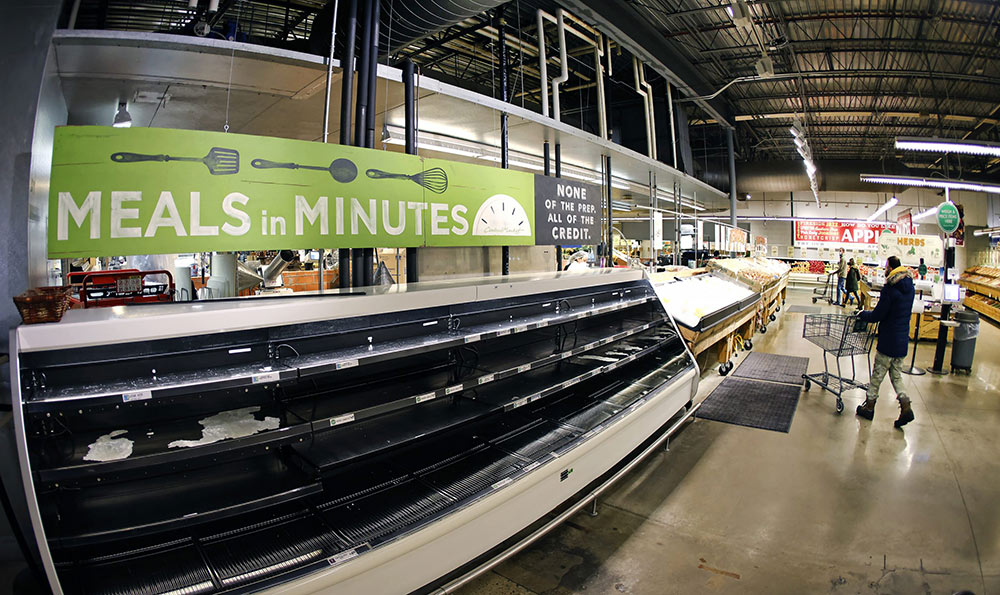
得州电网断电、密歇根州饮用水污染、明尼那波利斯大桥倒塌,这些案例真实或形象地说明,美国基础设施已经达到了其承受能力的极限。
这些并非是孤立的问题,而是让美国及其经济倍感压力的系统性故障。随着国家经济实力的衰败,人们将失去其生活和生计。
然而好消息在于,解决全美基础设施问题,无论从短期还是从更重要的长期来讲,都将有利于经济的发展。美国经济过去之所以强大是因为我们有良好的基础设施。如今,美国经济依赖的是其竞争力,而不是其基础设施。
改善基础设施是少数能够在美国公众中获得两党支持的事项之一。80%的美国民众对美国基础设施重建表示支持,这一比例高于人们对美国其他任何重大问题的共识,而且约三分之二的美国人认为其所在地区道路的路况一般或很差。同时,还有类似比例的美国民众认为美国在满足基础设施需求方面做得还不够到位。
改善基础设施也是一项复杂的挑战,涉及众多利益相关方。例如,联邦政府和各州负责高速公路建设和维护;当地政府负责水和下水道基础设施;互联网通讯则由私营公司负责。与此同时,大量的预算赤字也让这些政府无力投资、维护和翻修基础设施。
如何实现基础设施的现代化,并保持其良好的状态,才可以让经济变得强大并不断增长?我们在下文列举了一些颇具全面性、财政可持续性和成本效益,而且将获得两党支持的基础设施项目关键组件。
首先,改革监管机制。经过合理制定法规能够促进竞争,而且反过来将有助于以最低的成本获得最好的基础设施。精简监管流程,削减联邦、州和当地政府的繁文缛节,对于提升投资、减少成本和实现效率最大化有着重要作用。
严格的成本效益分析对于任何智能监管机制来说至关重要。建造和维修活动的竞争性投标亦十分重要。联邦政府可以提供技术专长,但我们也需要有关当地实际成本和效益的信息。
第二,进行战略思考。我们需要以长远眼光进行投资,而这意味着让美国回归可持续的财政道路,此举将为持续的投资创造更多的空间。
从长远角度思考还意味着确保维护和翻修能够在收益和成本方面与项目重建竞争所需的资金。电力行业需要可靠性,要求具备一定的余量和过剩容量,以及对电网和输送网络的严格评估和维护。投资开发更好的电池技术十分重要。
基础设施决策还必须考虑不断发展的科技,例如无人驾驶车辆和不断发展的数字通讯技术。我们有必要对基础设施投资科技进行研究(例如更耐用的高速公路,铺设厚度更厚,或将捕捉的碳嵌入混凝土),以改善生产力、降低成本,并保护环境。高品质的宽带已经成为市民和实现公平机会的必需品。我们必须考虑长期风险,例如气候风险和韧性。
第三,明智决策,并对财政负责。基础设施往往涉及多个试图实施刻板解决方案的参与者。联邦、州和当地决策者(包括跨州和跨地区)必须在项目审批期间通过更好地协调来避免重复和延迟,比如495号州际公路伍德罗威尔森大桥(Interstate 495 Woodrow Wilson Bridge)翻修工程,该桥横跨马里兰州和弗吉尼亚州之间的波托马克河,但因为多重评估而进展缓慢。
与此同时,决策者们需要为每个独特的项目选择最佳的资助工具,包括探索替代方式,从而使用私人投资资源。在适合开展公私合营的项目中(仅适用于某些基础设施),他们可以用于补充公共专长和资源。
我们必须以可持续的方式来使用高速公路信托基金。在短期内,这意味着提升燃油税。从更长远来看,它面临着巨大的资金挑战,因为社会正在转而使用并不含有当前燃油税的可再生燃料。
以上只是构成良好基础设施项目的一些组件,但其广泛的涉及范围凸显了我们面临的挑战的难度。这要求全美上下协调一致、同心协力。是时候了,政策领导者和其他决策者应该铺好道路,让美国再次踏上征程。(财富中文网)
杰克·霍克玛是Kaiser Aluminum公司董事长。
维基·珀珀尼是美国本田汽车公司前任客户数字旅程业务副总裁。
内森·罗森博格是Insigniam公司创始合伙人。
本文作者是世界大型企业联合会经济发展委员会董事,及其基础设施委员会的联席主席。
译者:冯丰
审校:夏林
得州电网断电、密歇根州饮用水污染、明尼那波利斯大桥倒塌,这些案例真实或形象地说明,美国基础设施已经达到了其承受能力的极限。
这些并非是孤立的问题,而是让美国及其经济倍感压力的系统性故障。随着国家经济实力的衰败,人们将失去其生活和生计。
然而好消息在于,解决全美基础设施问题,无论从短期还是从更重要的长期来讲,都将有利于经济的发展。美国经济过去之所以强大是因为我们有良好的基础设施。如今,美国经济依赖的是其竞争力,而不是其基础设施。
改善基础设施是少数能够在美国公众中获得两党支持的事项之一。80%的美国民众对美国基础设施重建表示支持,这一比例高于人们对美国其他任何重大问题的共识,而且约三分之二的美国人认为其所在地区道路的路况一般或很差。同时,还有类似比例的美国民众认为美国在满足基础设施需求方面做得还不够到位。
改善基础设施也是一项复杂的挑战,涉及众多利益相关方。例如,联邦政府和各州负责高速公路建设和维护;当地政府负责水和下水道基础设施;互联网通讯则由私营公司负责。与此同时,大量的预算赤字也让这些政府无力投资、维护和翻修基础设施。
如何实现基础设施的现代化,并保持其良好的状态,才可以让经济变得强大并不断增长?我们在下文列举了一些颇具全面性、财政可持续性和成本效益,而且将获得两党支持的基础设施项目关键组件。
首先,改革监管机制。经过合理制定法规能够促进竞争,而且反过来将有助于以最低的成本获得最好的基础设施。精简监管流程,削减联邦、州和当地政府的繁文缛节,对于提升投资、减少成本和实现效率最大化有着重要作用。
严格的成本效益分析对于任何智能监管机制来说至关重要。建造和维修活动的竞争性投标亦十分重要。联邦政府可以提供技术专长,但我们也需要有关当地实际成本和效益的信息。
第二,进行战略思考。我们需要以长远眼光进行投资,而这意味着让美国回归可持续的财政道路,此举将为持续的投资创造更多的空间。
从长远角度思考还意味着确保维护和翻修能够在收益和成本方面与项目重建竞争所需的资金。电力行业需要可靠性,要求具备一定的余量和过剩容量,以及对电网和输送网络的严格评估和维护。投资开发更好的电池技术十分重要。
基础设施决策还必须考虑不断发展的科技,例如无人驾驶车辆和不断发展的数字通讯技术。我们有必要对基础设施投资科技进行研究(例如更耐用的高速公路,铺设厚度更厚,或将捕捉的碳嵌入混凝土),以改善生产力、降低成本,并保护环境。高品质的宽带已经成为市民和实现公平机会的必需品。我们必须考虑长期风险,例如气候风险和韧性。
第三,明智决策,并对财政负责。基础设施往往涉及多个试图实施刻板解决方案的参与者。联邦、州和当地决策者(包括跨州和跨地区)必须在项目审批期间通过更好地协调来避免重复和延迟,比如495号州际公路伍德罗威尔森大桥(Interstate 495 Woodrow Wilson Bridge)翻修工程,该桥横跨马里兰州和弗吉尼亚州之间的波托马克河,但因为多重评估而进展缓慢。
与此同时,决策者们需要为每个独特的项目选择最佳的资助工具,包括探索替代方式,从而使用私人投资资源。在适合开展公私合营的项目中(仅适用于某些基础设施),他们可以用于补充公共专长和资源。
我们必须以可持续的方式来使用高速公路信托基金。在短期内,这意味着提升燃油税。从更长远来看,它面临着巨大的资金挑战,因为社会正在转而使用并不含有当前燃油税的可再生燃料。
以上只是构成良好基础设施项目的一些组件,但其广泛的涉及范围凸显了我们面临的挑战的难度。这要求全美上下协调一致、同心协力。是时候了,政策领导者和其他决策者应该铺好道路,让美国再次踏上征程。(财富中文网)
杰克·霍克玛是Kaiser Aluminum公司董事长。
维基·珀珀尼是美国本田汽车公司前任客户数字旅程业务副总裁。
内森·罗森博格是Insigniam公司创始合伙人。
本文作者是世界大型企业联合会经济发展委员会董事,及其基础设施委员会的联席主席。
译者:冯丰
审校:夏林
A failing power grid in Texas, poisonous drinking water in Flint, Mich., a bridge collapse in Minneapolis: Such examples illustrate the literal and figurative breaking point America’s infrastructure has reached.
These are not isolated problems, but a system failure that compounds the stresses on the country and its economy. Lives and livelihoods are lost as the nation’s economic strength is sapped.
The good news, though, is that addressing the national infrastructure will have salutary economic effects in both the short term and, more important, the long term. The U.S. economy used to be strong because of our infrastructure. Now, the U.S. economy hangs on to competitiveness despite our infrastructure.
Improving infrastructure is one of the few issues that enjoys strong bipartisan support among the American public. Eighty percent of Americans support rebuilding our nation’s infrastructure—more agreement than on almost any other top issue facing the nation—and roughly two-thirds of Americans rate their own local roads as in fair or poor condition. A similar proportion say that the country is not doing enough to meet infrastructure needs.
Improving infrastructure is a complex challenge involving many stakeholders. The federal government and states, for example, handle highway construction and maintenance; localities are responsible for water and sewer infrastructure; Internet communications are handled by private interests. All the while, huge budget deficits make investing in and repairing and renewing infrastructure look unaffordable.
How can we modernize our infrastructure, and keep it sound, so that our economy is strong and growing? Here are critical components of a bipartisan, comprehensive, cost-efficient, and fiscally sustainable infrastructure program:
First, reform the regulatory regime. Properly instituted, regulation can promote competition, which in turn will help us get the best infrastructure at the least cost. Streamlining regulatory procedures and cutting red tape across federal, state, and local governments is key to increasing investment, decreasing cost, and maximizing efficiency.
Rigorous cost-benefit analysis is essential to any smart regulatory scheme. Competitive bidding for construction and maintenance are essential. The federal government can provide technical expertise, but locally based, on-the-ground input regarding both costs and benefits is needed as well.
Second, think strategically. We need to invest for the long term, and that means putting ourselves on a sustainable fiscal course, which will create more room for enduring investment.
Thinking for the long term also means ensuring that maintenance and renewal compete with new construction for infrastructure dollars on the basis of benefits and costs. The electricity sector needs reliability, which requires some redundancy and excess capacity, along with rigorous evaluation and maintenance of the power grid and distribution network. Investing in developing better battery technology is essential.
Infrastructure decisions must also anticipate evolving technologies such as autonomous vehicles and advancing digital communications. Research into infrastructure investment technology (such as longer-lasting highways with thicker paving or embedding captured carbon in concrete) will be needed to improve productivity, reduce costs, and protect the environment. Access to quality broadband has become a necessity of citizenship and equal opportunity. And we must account for long-term risks, such as climate risk and resilience.
Third, act smartly and in a way that is fiscally responsible. Too often infrastructure involves a multitude of actors trying to implement inflexible solutions. Federal, state, and local decision-makers (including across states and localities) must better coordinate to avoid duplication and delay during project approvals. A multistate, multi-local jurisdiction project—such as the Interstate 495 Woodrow Wilson Bridge renewal across the Potomac between Maryland and Virginia—was slowed by multiple reviews.
At the same time, policymakers need to select the best funding tool for each unique project, including exploring alternative approaches for utilizing private investment resources. Where public-private partnerships are appropriate—which is for only some infrastructure—they can supplement public expertise and resources.
The Highway Trust Fund must be put on sustainable footing. In the short run, that will require increases in the fuel tax. The longer term poses significant funding challenges, assuming a continuing shift toward renewable fuels that do not bear the current fuel tax.
These are just some components of a sound infrastructure program, but their sheer breadth illustrates the magnitude of the challenge we face. It requires a coordinated, all-hands national response. It is now time for policy leaders and other decision-makers to apply the rubber to the road and get us moving again.
Jack Hockema is executive chairman of Kaiser Aluminum.
Vicki Poponi is former vice president of digital customer journey at American Honda Motor Co.
Nathan O. Rosenberg is founding partner of Insigniam.
The authors are trustees of the Committee for Economic Development of the Conference Board and cochair its Infrastructure Committee.






